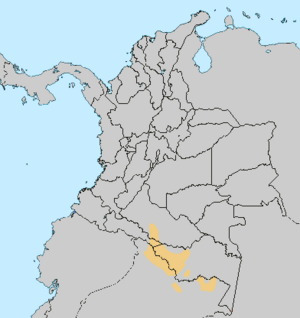| Bora–Witóto | |
|---|---|
| Witotoan | |
| (controversial) | |
| Geographic distribution | northwestern Amazon |
| Linguistic classification | Proposed language family |
| Subdivisions | |
| Glottolog | None |
 | |
Bora–Witóto (also Bora–Huitoto, Bora–Uitoto, or, ambiguously, Witotoan) is a proposal to unite the Boran and Witotoan language families of southwestern Colombia (Amazonas Department) and neighboring regions of Peru and Brazil. Kaufman (1994) added the Andoque language.
YouTube Encyclopedic
-
1/4Views:14 5635 14774 5822 862
-
Comunidad Indígena Uitoto: Estudio sociolingüistico
-
Lenguas Nativas de Colombia (Documental)
-
TOP 50 FRASES ESSENCIAIS EM GUARANI PARA INICIANTES
-
COLOMBIA - WikiVidi Documentary
Transcription
Family division
Kaufman (1994) lists Bóran and Witótoan (Huitoto–Ocaina) as separate families (they are grouped together with Andoque as Bora–Witótoan; by 2007 he moved Andoque to Witotoan). (Note that Andoque was later demonstrated to be part of the Andoque–Urequena family.)
Genetic relations
Aschmann (1993) proposed Bora–Witoto as a connection between the Boran and Witotoan language families. Echeverri & Seifart (2016) refute the connection.
Kaufman (2007) includes Bora-Witoto in his Macro-Andean proposal, and added the Andoque language to the Witotoan family.[1] (Aschmann had considered Andoque a language isolate.) These proposals have not been accepted by other linguists. Gildea and Payne (2007) checked Bora-Witoto with Andoque, Proto-Cariban and Yagua, and found Bora-Witoto to be not related to any of the others.
Mason (1950: 236–238) groups Bora–Witoto, Tupian, and Zaparoan together as part of a proposed Macro-Tupí-Guaranían family.[2]
Vocabulary
Below is a comparison of selected basic vocabulary items in Proto-Bora-Muinane (i.e., Proto-Boran), Bora, Proto-Witotoan, Witoto, and Andoque.
gloss Proto-Bora-Muinane[3] Bora[4] Proto-Witotoan[5] Witoto[4] Andoque[4] head *niga-ɨ nīːkʷàɯ̀ ɨɸogɨ -tai hair *-hee- níːkʷākō ɨɸotɨraɨ ka-tai ʌka-be eye *aʤɨ-ɨ ācɯ̄ː uˑɨθɨ -ʔákʌ ear *nɨ()-meeʔu nɯ́mɨ̄̇ō ?**()po heɸo -bei nose *tɨhɨ-ʔu Tɨ́hɨ̄̇ò *topo-(ʔ) doɸo -pɤta tooth *iʔgai íʔkʷāhɨ̀ ?**iiʔ-gi-() iθido -kódi tongue *nehe nɨ́ːhɨ̄̇ʔkʷā ?**()pe iɨɸe -sodɤ̃ mouth *i-hɨ īʔhʲɯ̀ **(-)po(e) ɸue -ɸi hand *ʔutʦe ōhtsɨ̄̇ onoɟɨ -dobi foot *ttɨʔaai mēhtíā **(ï)ta() (lower leg) eˑɨɟɨ -dʌka breast *mɨppaino **xebae-gaï -ɲeé meat *ʔookuu, *duu éːkó ɟɨkɨθi -ɤ̃ta blood *tɨɨ **tï-xë(ʔe) dɨe -duʔs bone *bakkɨ p̻āhkɯ̄ iɟaikɨ -tadɤ̃ person *m()a-mɨnaa-ppi (sg.), *m()a-mɨnaa (pl.) kʷàhp̻ì ɨima ʝóʔhʌ name *momo **maime mamekɨ -ti dog *ʔuuʔi ōíp̻ʲē **xï̄ʔko hɨko ĩɲõ fish āmōmè ɟɨkɨaɨ bei louse *gaaini-ʔu kʷāánī ɨboma táʔsi tree *ɨmo-ʔo ɯ̄mèè ?**(aï)me() amena kɤ̃́ʔɤ̃dɤ leaf *-ʔaame ɨ́nāʔámɨ̄̇ rabe -sedɤ̃ flower θaɸia water *nɨ-ppai()u nēhp̻ākʲō **nō-() hɨnui dúʔu fire *kɨɨhɨ-gai kɯ́ːhɯ̄kʷā irai ʌʔpa stone néékʷājī **goti- noɸɨkɨ ɸisi earth *hiinɨ-he ìīɲɯ̀ *xáénï̄ʔ-xë enɨe ɲṍʔĩ salt *ɨmo **(ï)xaidzaï(ga) ɨaiθaɨ road **(na)xï̄() naˑɨθo dubɤ, õbɤ eat *matʧu **d(o)ʔ, **gōī(ne) guite -baʔi- die *gihe-βo baˑɨde ĩ-hʌ́ʌ- I *uu ōō **(k)ōō-xe(ʔe) kue o-ʔɤ you *ɨɨ **ō-xe(ʔe) o ha-ʔɤ
References
- ^ Kaufman, Terrence. 2007. South America. In: R. E. Asher and Christopher Moseley (eds.), Atlas of the World’s Languages (2nd edition), 59–94. London: Routledge.
- ^ Mason, J. Alden. 1950. The languages of South America. In: Julian Steward (ed.), Handbook of South American Indians, Volume 6, 157–317. (Smithsonian Institution, Bureau of American Ethnology Bulletin 143.) Washington, D.C.: Government Printing Office.
- ^ Seifart, Frank, & Echeverri, Juan Alvaro (2015). Proto Bora-Muinane. LIAMES: Línguas Indígenas Americanas, 15(2), 279-311. doi:10.20396/liames.v15i2.8642303
- ^ a b c González de Pérez, María Setlla (ed). 2000. Lenguas indígenas de Colombia: una visión descriptiva. Bogotá: Instituto Caro y Cuervo.
- ^ Aschmann, Richard P. (1993). Proto Witotoan. Publications in linguistics (No. 114). Arlington, TX: SIL & the University of Texas at Arlington.
Bibliography
- Aschmann, Richard P. (1993). Proto Witotoan. Publications in linguistics (No. 114). Arlington, TX: SIL & the University of Texas at Arlington.
- Campbell, Lyle. (1997). American Indian languages: The historical linguistics of Native America. New York: Oxford University Press. ISBN 0-19-509427-1.
- Echeverri, Juan Alvaro & Frank Seifart. (2016). Proto-Witotoan: A re-evaluation of the distant genealogical relationship between the Boran and Witotoan linguistic families.
- Gildea, Spike and Doris Payne. (2007). Is Greenberg's "Macro-Carib" viable? Bol. Mus. Para. Emílio Goeldi. Ciencias Humanas, Belém, v. 2, n. 2, p. 19-72, May-Aug. 2007 Online version: http://www.museu-goeldi.br/editora/bh/artigos/chv2n2_2007/Greenbergs(gildea).pdf
- Greenberg, Joseph H. (1987). Language in the Americas. Stanford: Stanford University Press.
- Kaufman, Terrence. (1990). Language history in South America: What we know and how to know more. In D. L. Payne (Ed.), Amazonian linguistics: Studies in lowland South American languages (pp. 13–67). Austin: University of Texas Press. ISBN 0-292-70414-3.
- Kaufman, Terrence. (1994). The native languages of South America. In C. Mosley & R. E. Asher (Eds.), Atlas of the world's languages (pp. 46–76). London: Routledge.
External links
- Familia Bora–Witoto at Proel
